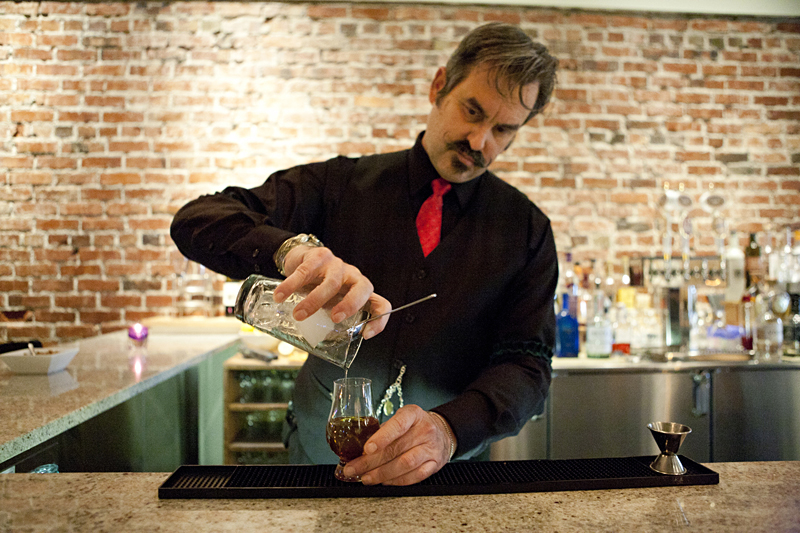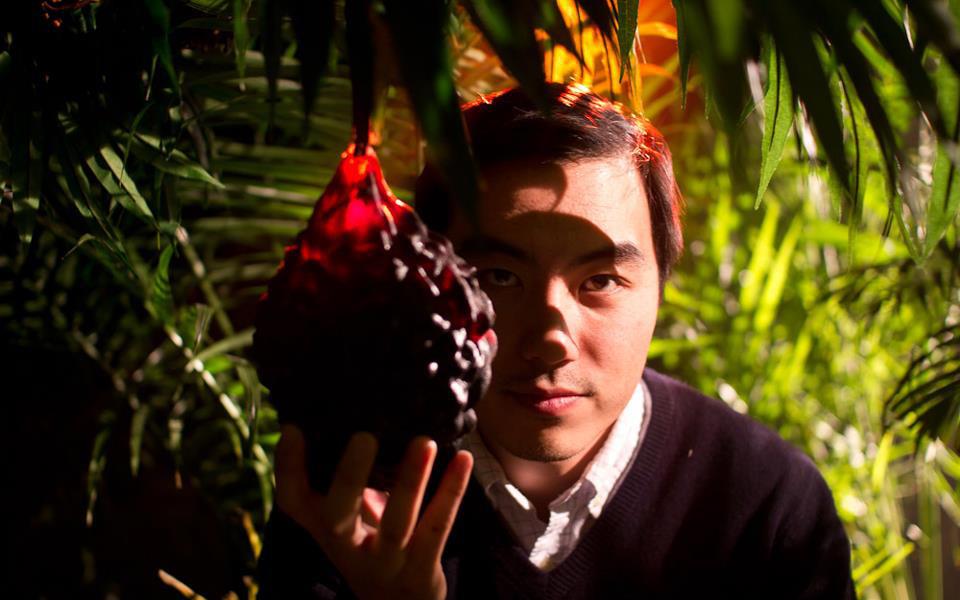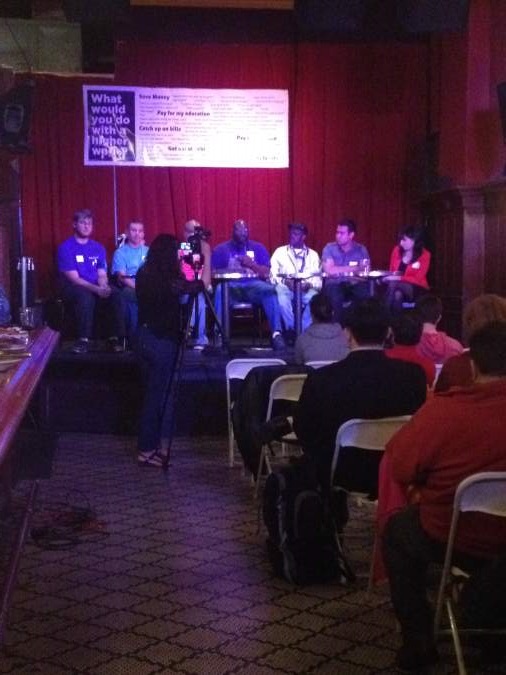The first American-born eaters who ventured into New York’s Chinatown for fashionable chop suey benders savored strangeness. In the company of tour guides who specialized in slum-gazing, wealthy white patrons pasted fake mustaches to their upper lips, slipped behind secret doors to peer at opium smokers, and sampled soy-soaked hashes in sketchy basement restaurants run by chefs too savvy to allay their enthralled patrons’ fears that they might be eating rat tails and dog flesh.
But as the rage for Chinese food reached the heartland, the emphasis on exoticism disappeared. Depression-era housewives were more interested in the price of canned water chestnuts than inter-tong warfare. They liked Chinese food because it was hearty and cheap. Chinese restaurateurs appealed to them with enormous family dinners featuring a congress of fried egg rolls, egg foo young, subgum soup, and almond chicken. By the 1950s, these restaurants developed a menu system to reassure even the most bigoted Organization Man that there was nothing slapdash or scary about eating Chinese: Choosing one dish from Column A and another from Column B was orderly and easily understood.
Bako, the comely new Chinese-themed lounge on Capitol Hill, is also courting a non-Cantonese clientele, yet there’s nothing here approaching the neatness of a dual-column menu strategy. The restaurant’s dizzy confusion harkens back to the premeditated woolliness of the earliest stateside Chinese restaurants. After a pair of meals disrupted by reservation mix-ups, forgotten dishes, and spilled drinks, I would have killed for a saucer of duck sauce and a server willing or able to bring me the noodle soup I wanted.
“I am in a steep learning curve right out of the gate,” Bako owner Keeman Wong pleaded with a Yelp commentator who snipped about “just okay” food a month after the restaurant opened. Wong’s family owned Ming’s and Wayen Diners in Vancouver, B.C., but Bako is his first solo project. While Wong has aced his restaurant’s decor—tricked out with references to Hong Kong cinema, it’s downright foxy—he’s apparently struggled to master the aspects of food service that involve real, live, unpredictable people.
Foremost among that raggedy crew might have been the two chefs who’ve taken turns at the helm. Augusto Cadillo, the opening chef, left before the restaurant celebrated its two-month anniversary. “He understood his vision wasn’t complementary to Bako’s direction,” Wong explains. On a server’s recommendation, he was replaced by Chris Michel. “While opening a restaurant is the hardest thing I’ve ever done, mentally, physically, and emotionally, transitioning to a new chef in my restaurant’s infancy has been the second-hardest,” Wong says.
Michel, late of Ba Bar and Monsoon East, showed up with all the hard-driving razzle-dazzle a reliever’s supposed to bring to the game. He promptly dropped the pork loin from a char siu preparation, and started serving barbecued pork belly instead. (Pow!) He axed a plate of daikon cakes, replacing it with a salad of thinly sliced daikon and crisp yellow-skinned apple wedges. (Kaboom!)
Still, it turns out there are problems even bacon and fruit can’t fix: I never ate at Bako during Cadillo’s regime, but the restaurant’s current cuisine is largely a blur of grease and oil.
It’s hard to tell from Bako’s menu how diners are supposed to order. Eaters accustomed to traditional Chinese-American menus are likely to assume won ton soup, pot stickers, and clams in black-bean sauce constitute a meal. But if so, they’ll go home very hungry.
Bako’s dealing in small plates, which means four to five dishes a person isn’t an outrageous calculation. Neither of our servers made that clear when we asked for help. To the contrary, both urged us to scale back our orders—and our first server had very precise advice about which dishes weren’t worth summoning.
Warm peanut salad, he instructed us, was not something we’d like. We would much prefer the apple daikon salad. Protestations that turned on a longtime love of boiled peanuts not only failed to sway him, they cued eaters at a neighboring table to chime in on his behalf. (“Neighboring” may be a slight overstatement: The tables at Bako are shoved together so closely it would be difficult to jam a decent dictionary between them.) Our fellow diners assured us that our server had a prodigal palate, and should be entrusted with all our menu decisions. They were soon nostalgically recalling the first time they’d dined under the server’s tutelage—I think it was the previous week—and how he’d steered them to the most mind-blowing flavors imaginable.
So we went with the apples. Except for a few sprigs of feathery fennel, the salad was as ivory as resume paper. There was crispness and crunch, but the fruit sloughed the distinctive sweetness that makes apples a perpetual hit in nursery-school classrooms.
I was allowed to order the peanut salad on a subsequent visit, and am still baffled by what might make it so objectionable, other than the dexterity required to clasp slick braised peanuts between chopsticks. The dish, really more bar snack than salad, consists of a pile of softened peanuts bundled in soy and dashed with a shake of cinnamon and red pepper. Like much of what’s served at Bako, the peanuts are somewhat soggy and brown, but they’re at least dosed with flavor.
Blandness is a recurring issue at Bako. A hot pot seeded with mushrooms, greens, and a hulking duck leg tasted exactly like nothing. A droopy congee and an oily chicken soup with a skein of fresh noodles were similarly flavorless. Other dishes had flavor, but only one apiece: Gritty Singapore noodles, joined on the plate by three overcooked shrimp, wore a thick curry coat. Ginger noodles interspersed with scallions and bean sprouts blazed with ginger. Shrimp potstickers were overwhelmingly fishy.
The downside of small plates is the incessant repetition of disappointment. Even if it all adds up to the same number of dollars spent and ounces eaten, half-a-dozen flawed miniatures are always more disheartening than one lousy normal-sized dish—especially when they’re spaced out over a very long evening because of service flubs. “I put that on the back burner while I did drinks,” our server told us by way of explaining the prolonged arrival of our food. “I’ve had a night,” she later groaned after dropping a used fork on one of my guests, then leaving without apology.
It’s not all culinary sorrow at Bako, however. There are a few successful items on the menu, including Michel’s gloriously piggy hunks of glazed pork belly. A brawny eight-treasure rice is a hillock of al dente grains, carrots, mushrooms, scallions, and Chinese sausage, overlaid with a gently fried egg.
The drinks list is an even surer source of satisfaction. While the cocktails don’t have nearly as much panache or polish as those available elsewhere in the neighborhood, bartender Guy Lafitte makes good use of fresh citrus and shochu. He’s also extraordinarily proud of his rye Manhattan, which, in accordance with classic cocktail protocol, he stirs rather than shakes. With so many five-spice-reliant dishes on the table, I found Sangiovese a better pairing beverage than any of the cocktails I tried, but there’s no rule requiring Bako’s guests to stay for dinner. In fact, the restaurant’s studiously swanky ambience makes it an ideal setting for simply drinking.
Bako’s interior boasts a glamour rare in Seattle. In a city ruled by wood and earth tones, Wong’s put together a room with a sultry white glow. There are gauzy curtains in the front windows and around the long table that separates the clean-lined bar from the main dining area, wallpapered in a gold paisley pattern. This is a room in which to meet a fellow spy or a clandestine lover. There are plenty of other places for eating pork buns.
Price Guide
Shrimp potstickers $8
Apple salad $7
Peanut salad $7
Eight-treasure rice $11
Singapore noodles $13
Duck hot pot $17








